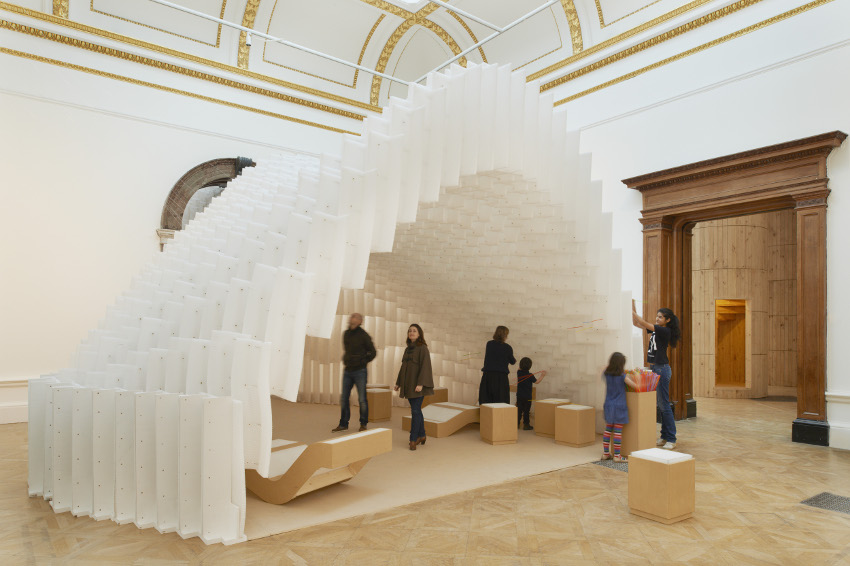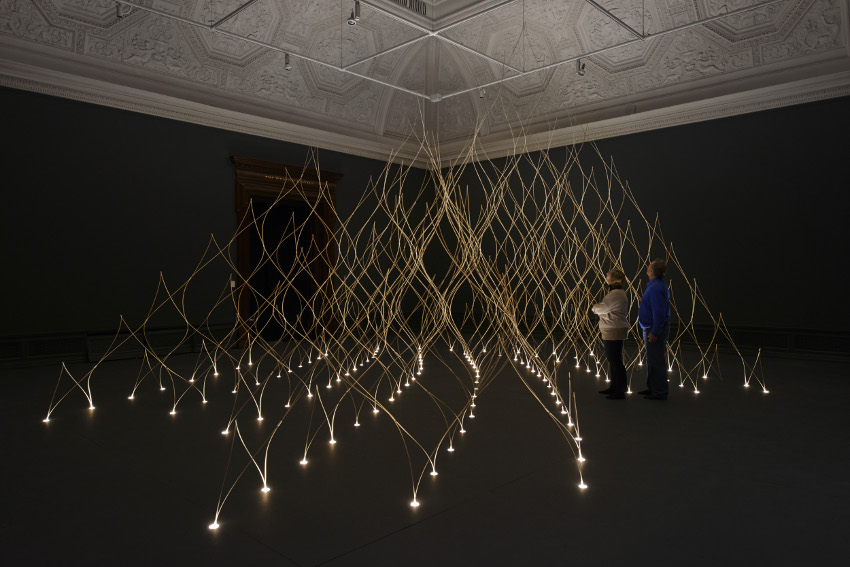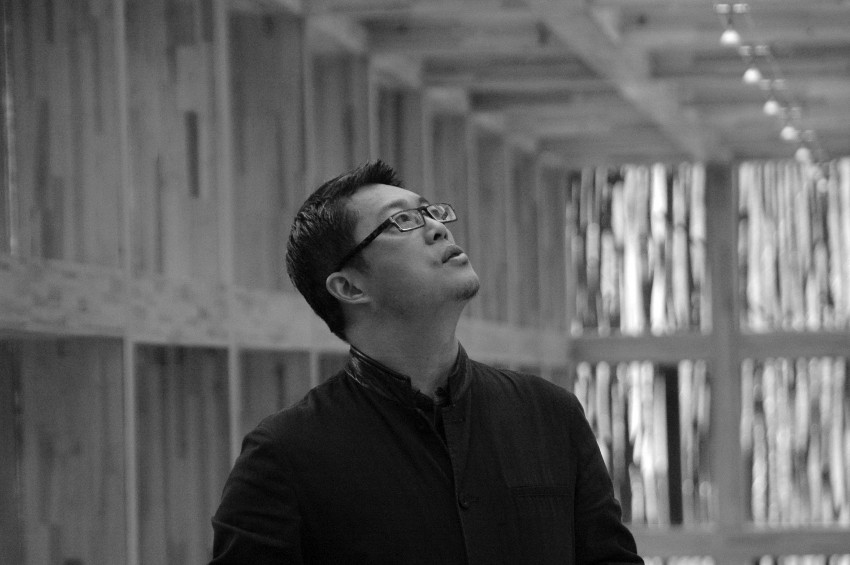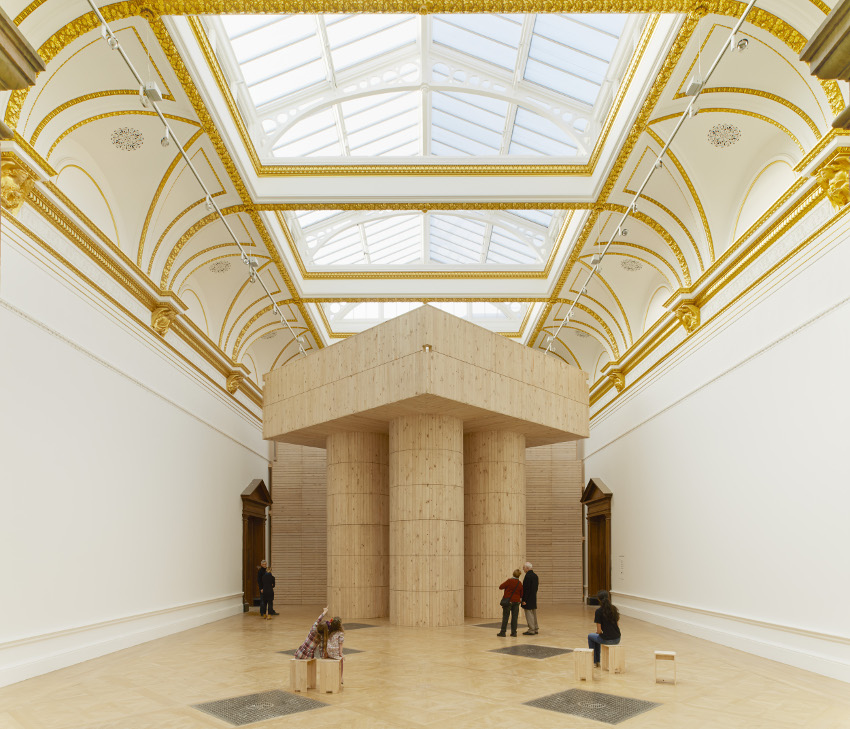The Royal Academy makes a successful break from its usual formula as it invites seven contemporary architects to transform its Beaux-Arts galleries…
When were you last aware of the spaces you inhabit? It’s all too easy to ignore architecture as we rush between home and work, the gym and the supermarket – such spaces are too familiar or unremarkable to arrest our attention. But, occasionally, something will jolt us out of this mono-vision: we’ll look up and see a building from a fresh perspective, turn off a busy street into the calm and quiet of a deserted courtyard, or notice the light striking a landmark just so.

Installation by Francis Kere
It’s this very sensation that the Royal Academy seeks to “awaken and recalibrate” with their latest exhibition,Sensing Spaces: Architecture Reimaged. Seven leading contemporary architects from across the globe have been commissioned to build ‘interventions’ (installations) that illuminate the sensory and experiential properties of spaces and encouraging visitors to look beyond the purely functional or visual ways in which buildings are usually regarded. There could hardly be a better scene-setter for this than the Royal Academy’s own majestic quad – a relief after being jostled along Piccadilly, with sunlight spreading across the creamy Portland stone and gilding the statues of Wren, Raphael et al embedded in its façade.
Inside, meanwhile, the seven architects have cast the Academy’s Beaux-Arts galleries in an entirely new light – as well as, in some cases, highlighting the beauty that was already there. Pezo von Ellrichschausen is definitely in the latter camp; the Chilean duo’s robust, imposing structure supported by four fat columns brings to mind a Grecian temple, yet rendered in Chilean pine it becomes a hybrid of the classical and organic. Unadorned and bulky, its minimalism allows the room around it to shine. A ramp and several spiral staircases concealed within the structure all lead up to a viewing platform, bringing visitors a rare close-up of the gallery’s ornate gold-leaf cornice and ceiling – it is, as exhibition curator Kate Goodwin says, “a world we never normally see”.

Installation by Kengo Kuma
Pritzker Prize-winning Eduardo Souto de Moura (Portugal) also pays homage to the Academy’s architecture with two concrete casts of the gallery’s doorframes. Placed at an angle beside the original archways, these form subtle tributes that mirror or echo the gallery’s forms.
We are taken further from the familiar, meanwhile, by Japanese architect Kengo Kuma. In a darkened chamber, bamboo rods rise up out of floor-level LED lights and interlace to form a large pyramid structure. The effect is ethereal: the bamboo looks fine as copper wire and fragile, yet there is a sense of rigid, geometrical precision. While we view this pavilion from the outside, Kuma’s second room forces us ‘within’ the architecture. The bamboo structure now becomes oppressive, a cave that surrounds the viewer and rises up overhead (it was apparently influenced by memories of sitting under a mosquito net as a child).

Architect Li Xiaodong
A similar sense of beguilement and unease is created in Li Xiadong’s (China) labyrinth. Tall timber walls ensure the way ahead is continually obscured, enhancing the particpant’s surprise when happening upon small plywood cabins and peepholes along the way, and, ultimately, the ‘Zen garden’ with a mirrored wall and shingle floor that lies at the end. Testament to the transformative power of architecture, there’s a powerful shift from the instinctive unease one feels in Xiaodong’s dark forest to Diebedo Francis Kere’s (Germany/Burkina Faso) playful contribution. Highly tactile and engaging, visitors are encouraged to make their mark on the tunnel-like structure by threading brightly coloured straws into the perforated plastic panels.
Finally, Grafton Architects use light as their architectural language, creating two dramatically contrasting effects in neighbouring rooms simply by hanging forms in two different ways – in Gallery IX, nine white ‘blades’ suspended from the ceiling serve to channel and reflect the natural light flooding down from the glass roof, while in the Lecture Room massive, dark forms filling the space above our heads leave only the smallest openings of light, for a more quietly contemplative space in which subtle gradations of shadow are the only focus.

Installation by Pezo von Ellrichshausen
Unusually, there is no prescribed route through Sensing Spaces, and just one of the seven installations (Xiaodong’s) must be approached from a set direction. Instead, Goodwin wishes visitors to navigate the exhibition freely as they would a city; the idea is to wander, re-approach and stumble upon installations from different angles. It’s a pertinent approach for a architecture show, considering how often buildings show you entirely new faces when seen from different angles. Take St Paul’s, for example: a hulking, neck-stiffening colossus when viewed along its flanks, the cathedral takes on a neat, picturesque aspect from the Millennium Bridge, framed between glass office blocks.
The Royal Academy may be out of its comfort zone with an exhibition dedicated to contemporary architecture rather than a blockbuster Impressionist painter or similar, but this is a welcome experimental leap that reminds us how architecture is more than an assemblage of glass, concrete and steel; it’s elemental and provocative, and in its best form it briefly lifts our tunnel vision and prompts us to look a little closer at the world around us.
Sensing Spaces: Architecture Reimagined is now on at the Royal Academy of Arts, Piccadilly, London, until 6th April 2014. For more information and tickets visit the website.
Special Caprice promotion: For just £40 you can enjoy a three course late lunch or early supper with an exclusive cocktail (Vitruvius Poison containing Ciroc vodka, Aperol, lime juice, grapefruit juice, sugar & Peychaud’s bitters) and exhibition ticket. To book call 020 7629 2239 quoting ‘RA Sensing Spaces’. The package must be paid for at the time of booking and tickets collected from Le Caprice. The exhibition tickets are valid until the show closes on Sunday, 6 April. And don’t forget to mention you saw the promotion in The Arbuturian!




